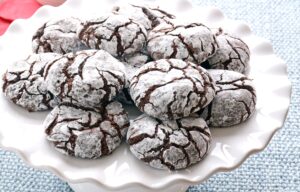




This bread is traditional in the Westphalia region of Germany. Made from coarsely ground Rye flour and a small portion of wheat flour, traditional Pumpernickel is a heavy, coarse-textured dense bread that is very dark brown, almost black at times. There is usually virtually no crust since it is baked in a deep narrow pan with a lid that is like a Pullman’s loaf pan that steams the loaf. This bread is slowly baked for 16-24 hours in a lower temperature oven, around 300°F. The long baking time creates a Maillard reaction between the acids in the starter and the natural sugars which then naturally darken the loaf. There is no browner or sweetener added! The taste is slightly sweet and slightly sour. There are no caraway seeds, as there are in the America version. Because the bread is so dense, it usually sliced very thin.
We found it interesting that there are specific German Food laws that govern Pumpernickel making:
“Pumpernickel is made of at least 90 percent rye flour and/or whole grain rye with baking times of at least 16 hours. (Pumpernickel wird aus mindestens 90 Prozent Roggenbackschrot und/oder Roggenvollkornschrot mit Backzeiten von mindestens 16 Stunden hergestellt. )” [1]
“Added browner or sweeter is not allowed.” (Der Zusatz bräunender oder süßender Stoffe ist nicht erlaubt. )” [2]
This bread, made with the help of commercial yeast, is an excellent accompaniment to any hearty soup. It’s made with whole grain rye flour, a.k.a. Pumpernickel. Rye flour has less gluten-forming protein than wheat, and so creates a denser bread.

We use bread flour in this recipe to help lighten it up a little for the American palate, but also use heritage wheat flours to add an authentic dense whole grain feel to the loaf. We are keeping with the German tradition of not using caraway seeds, though we did list it in the recipe for those who want to use it.

We use the molasses and coffee to help darken the loaf because most of our bakers just don’t have 16 hours to bake a loaf of bread as they do traditionally in the German Pumpernickel. The addition of the old-fashioned Kitchen Bouquet Browning and Seasoning Sauce is also optional, but it does add some extra flavor and color to the bread.

Keep in mind, when planning this dough, that we do use a sourdough starter and this should be fed and allowed to ferment overnight before using in the loaves. After you’ve put the loaves together and shaped them, it’ll need to rise for 2 or 3 hours before baking (depending on the temperature of your room). We’re using commercial yeast, so it is a little less traditional in that sense. Expect it to be dense, but not overly so. If you make one loaf, it’ll need to bake for about 45-55 minutes. Two loaves will each take about 35-40 minutes. Take this timing into consideration before you start. We are steaming our loaves in covered Dutch oven or Pullman’s loaves to keep with the almost crust-less traditional German bread as well. If you prefer a crusty bread, remove the cover after the first 15 minutes of baking.
1 ½ cups ripe (fed) sourdough starter
1 ½ cup room temp. water or black coffee
¼ cup minced dehydrated onions
2 Tbsp. Kitchen Bouquet Browning & Seasoning Sauce (optional)
2 tablespoons vegetable oil
2 tsp. instant yeast
2 teaspoons salt
2 tsp. caraway seed (optional)
1/3 cup dark black-strap molasses
2 cups Specialty Grains Organic Rye Flour
2 cups Panhandle Milling Organic Bread Flour
2 Cups Specialty Grains Organic Whole Wheat Einkorn Flour or Organic Whole Grain Kamut® Khorasan Wheat Flour
½ cup Viobin Cocoa Replacer (optional)
Directions:
There are many ways to shape this dough:
Cover the loaves with a piece of lightly oiled plastic wrap if not raising in a covered Dutch oven or Pullman’s loaf.
Let them rise in a draft-free spot. You can predict the amount of rising somewhat by the temperature of the space where they’re rising: at 55°F to 60°F, they’ll probably take 2 to 3 hours to raise; at 65°F to 70°F, 1 to 2 hours.
A short time before the loaves have doubled in size, place them, covered in a preheated 350°F oven; they’ll continue to rise during the first 15 minutes of baking. After 15 minutes, reduce the heat to 325°F.
Bake two smaller loaves for about 35-45 minutes; one large loaf will bake for about 45-55 minutes.
The loaves are done when the centers measure 200°F when measured with an instant-read thermometer. Remove from the oven and put on a rack to cool before slicing. Store in an airtight container. Yield: 1 or 2 loaves, 24 servings.
Tips from our bakers
Dough that contains rye four will never lose the tacky feel. Don’t add extra flour, as it will lead to dry, dense loaves. Lightly mist surfaces with water or oil to prevent sticking when forming loaves.

German Sources
[1] Heuts, Gabriele, editor. Leitsätze des Deutschen Lebensmittelbuchs für Brot und Kleingebäck. Bundesministeriums für Ernährung, Landwirtschaft und Verbraucherschutz. 9 July 2008. Page 5, # 12.
[2] Schünemann, Claus and Günter Treu. Technologie der Backwarenherstellung. Gildebuchverlag GmbH, 2005. Page 202.
#bread #sourdough